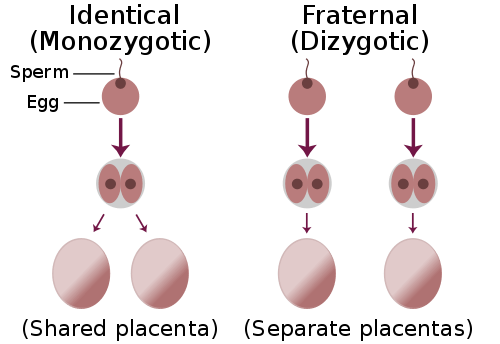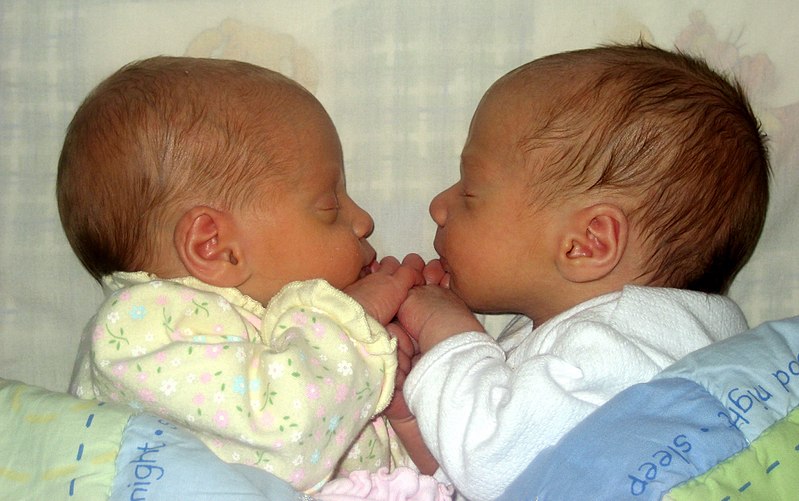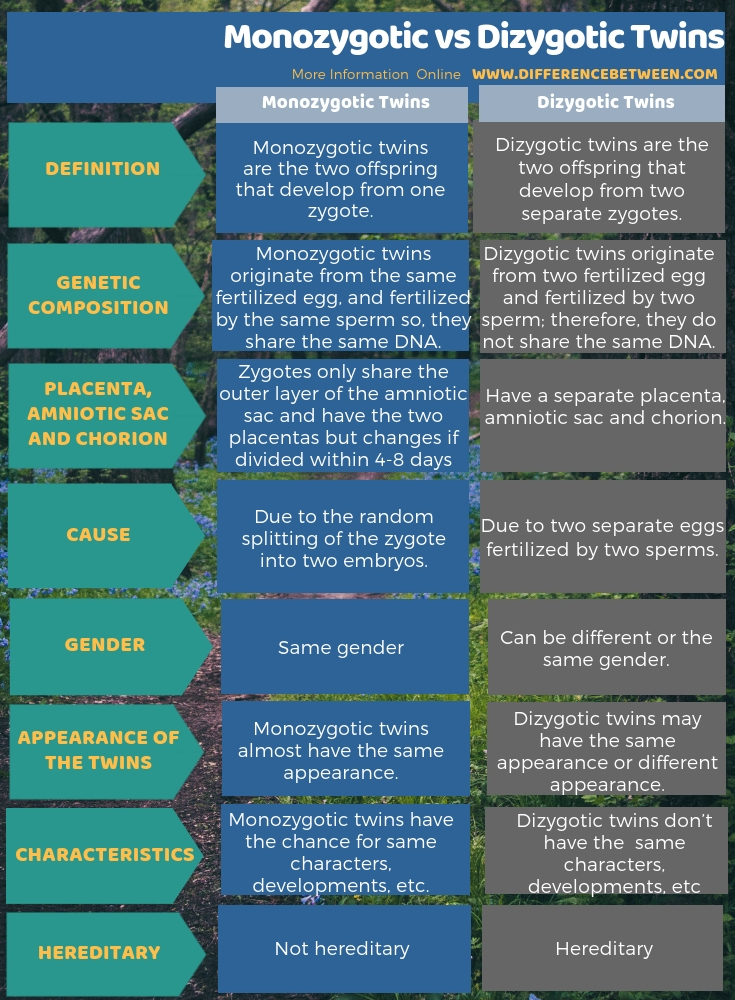Difference Between Monozygotic and Dizygotic Twins
Table of Contents
The key difference between monozygotic and dizygotic twins is that the monozygotic twins are identical since they develop from one zygote while the dizygotic twins are non-identical since they develop from two separate zygotes.
Twins are the two offspring produced in the same pregnancy. Therefore, they can be either monozygotic (identical) or dizygotic (fraternal). Families with a history of fraternal twins have a higher chance of producing more twins than families without twins. It is because fraternal twins are hereditary while identical twins are not. Fraternal twin results by a gene located in the X chromosome. Hence, if a man has fraternal twins in his family, he can pass the twin gene to his daughter.
There are five common variations in twinning. Among them, three variations are dizygotic (fraternal); male-female twins (the most common type), female-female dizygotic twins, and male-male dizygotic twins. Other two variations are monozygotic twins; male-male monozygotic twins and female-female monozygotic twins. Moreover, male-female monozygotic twins are possible but comparatively very rare. Consequently, the death rate in the uterus is higher for twins, and males are more susceptible to death than females.
CONTENTS
1. Overview and Key Difference
2. Who are Monozygotic Twins
3. Who are Dizygotic Twins
4. Similarities Between Monozygotic and Dizygotic Twins
5. Side by Side Comparison – Monozygotic vs Dizygotic Twins in Tabular Form
6. Summary
Who are Monozygotic Twins?
Monozygotic twins are “identical” twins. Identical twins occur when one zygote divides into two separate embryos. Hence, the term becomes monozygotic. In natural monozygotic twinning, the twins are formed when the blastocyst collapses splitting the progenitor cells into the half, and the genetic material divides into two on opposite sides of the embryo. Eventually, these two separate fetuses develop. The division of the zygote into two embryos is a spontaneous or random event. Hence monozygotic twins are not hereditary. Monozygotic twins can also be created artificially by embryo splitting.

Figure 01: Development of Twins
Almost all monozygotic twins are genetically identical, and always they are of the same sex unless there has been a mutation during the development. However, they don’t have the same fingerprints. On rare occasions, monozygotic twins may express different phenotype.
Conjoined twins are monozygotic twins whose bodies are joined together during pregnancy where the single zygote of monozygotic twins fails to separate, and the zygote starts to split after the 12th day following fertilization.
Who are Dizygotic Twins?
Dizygotic or fraternal twins are “non-identical” twins or dissimilar twins. The two eggs are independently fertilized by two different sperm cells, and the fertilized eggs are implanted in the uterus wall at the same time and become two zygotes. Hence, the term becomes dizygotic, and the result is fraternal twins.

Figure 02: Dizygotic Twins
Like other siblings, dizygotic twins also have an extremely small chance of having the same chromosome. They may have similar appearances or maybe very different from each other; also, they may be of the same sex or different sex. Notably, they are of the same age. Dizygotic twins are more common for older mothers, and above 35 years of age since the twinning rate doubles with age.
What are the Similarities Between Monozygotic and Dizygotic Twins?
- Monozygotic and dizygotic are two types of twining.
- Both produce unique individuals.
- Also, each has different fingerprints.
What is the Difference Between Monozygotic and Dizygotic Twins?
Monozygotic and dizygotic twins are two main types of twins. As the names suggest, monozygotic twins develop from one zygote while dizygotic twins develop from two separate zygotes. Therefore, this is the key difference between monozygotic and dizygotic twins. Monozygotic twins originate due to the splitting of the zygote into two halves randomly. On the other hand, dizygotic twins originate due to fertilization of two eggs from two separate sperms. Hence, this is a significant difference between monozygotic and dizygotic twins.
Moreover, monozygotic twins are identical while dizygotic twins are non-identical. Furthermore, monozygotic twins are not hereditary while dizygotic twins are hereditary. Thus, it is also a difference between monozygotic and dizygotic twins.
The below infographic provides more descriptions on the difference between monozygotic and dizygotic twins.

Summary – Monozygotic vs Dizygotic Twins
Twins can be either monozygotic or dizygotic. Monozygotic twins are identical, and they develop from one zygote. On the other hand, dizygotic twins are non-identical, and they develop from two zygotes. Furthermore, monozygotic twins originate randomly. Hence, they are not hereditary. On the other hand, dizygotic twins originate due to fertilization of two eggs from two sperms, and it is hereditary as well. Also, monozygotic twins share one placenta while dizygotic twins have two placentae. This is the summary of the difference between monozygotic and dizygotic twins.
Reference:
1. “Twin.” Wikipedia, Wikimedia Foundation, 28 Jan. 2019. Available here
Image Courtesy:
1.”Identical-fraternal-sperm-egg”By Trlkly – Own work (CC BY-SA 3.0) via Commons Wikimedia
2.”FraternalTwins”By MultipleParent (CC BY-SA 3.0) via Commons Wikimedia
ncG1vNJzZmivp6x7pbXFn5yrnZ6YsqOx07CcnqZemLyue8OinZ%2Bdopq7pLGMm5ytr5Wau265zqems7GXpMGqr4yapZ1lpqh6pbXZsp6orJmYerXDyKeqaA%3D%3D